Abstract
Several studies, using pH monitoring with event markers, have identified patients with normal oesophageal exposure to acid despite an apparent relation between symptoms and reflux episodes. In this series of 771 consecutive patients referred for 24 hour oesophageal pH monitoring, a probability calculation was used to evaluate the relation between symptoms and reflux episodes. Oesophageal exposure to acid was normal in 462 of 771 recordings (59.9%); despite this, 70.8% (327 of 462) of these patients used at least once the event marker. In 96 patients (12.5% of total patients) with normal oesophageal exposure to acid, there was a statistically significant association between symptoms and reflux episodes. The symptom cluster of such patients was similar to that usually seen in patients with gastro-oesophageal reflux disease, but symptoms like belching, bloating, and nausea were common thus overlapping with the symptom pattern of functional dyspepsia. In these patients both the duration and the minimum pH of reflux episodes (either symptom related or asymptomatic) were significantly shorter and higher, respectively, when compared with those of patients with gastro-oesophageal reflux disease. These results are consistent with the idea that oesophageal hypersensitivity to acid is the underlying pathophysiological feature of this syndrome.
Full text
PDF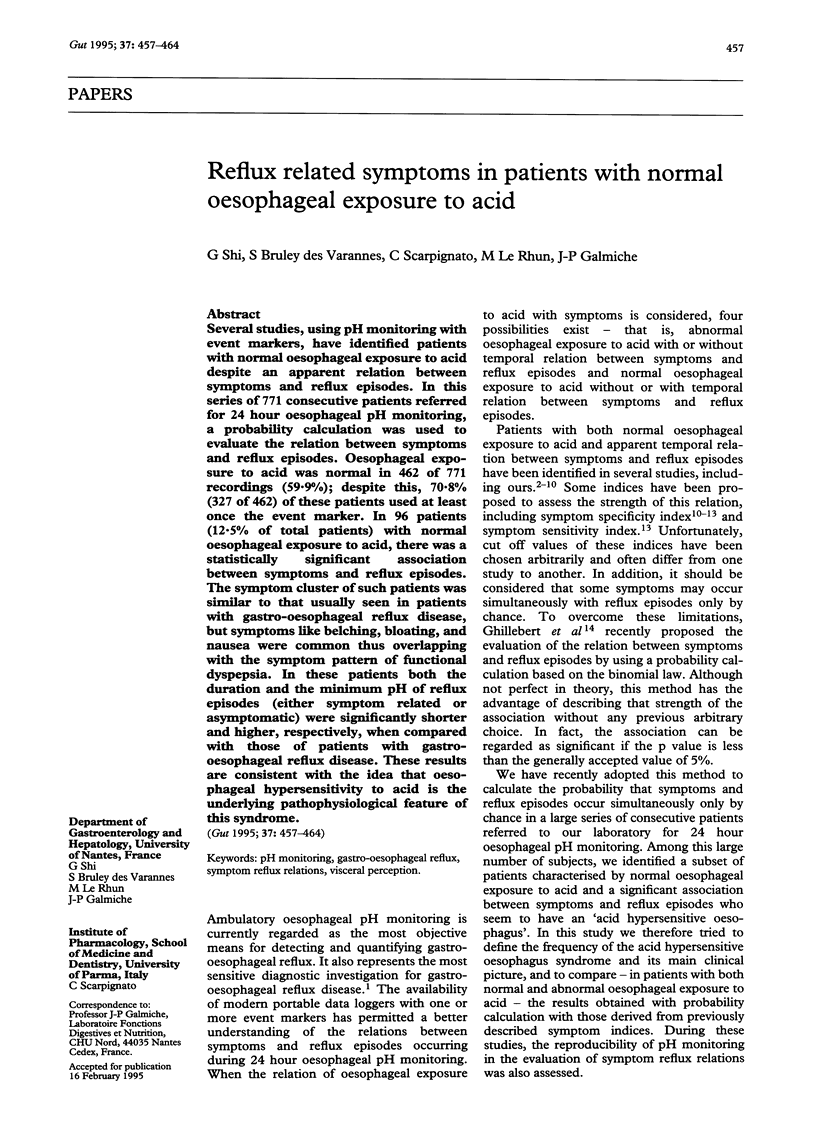
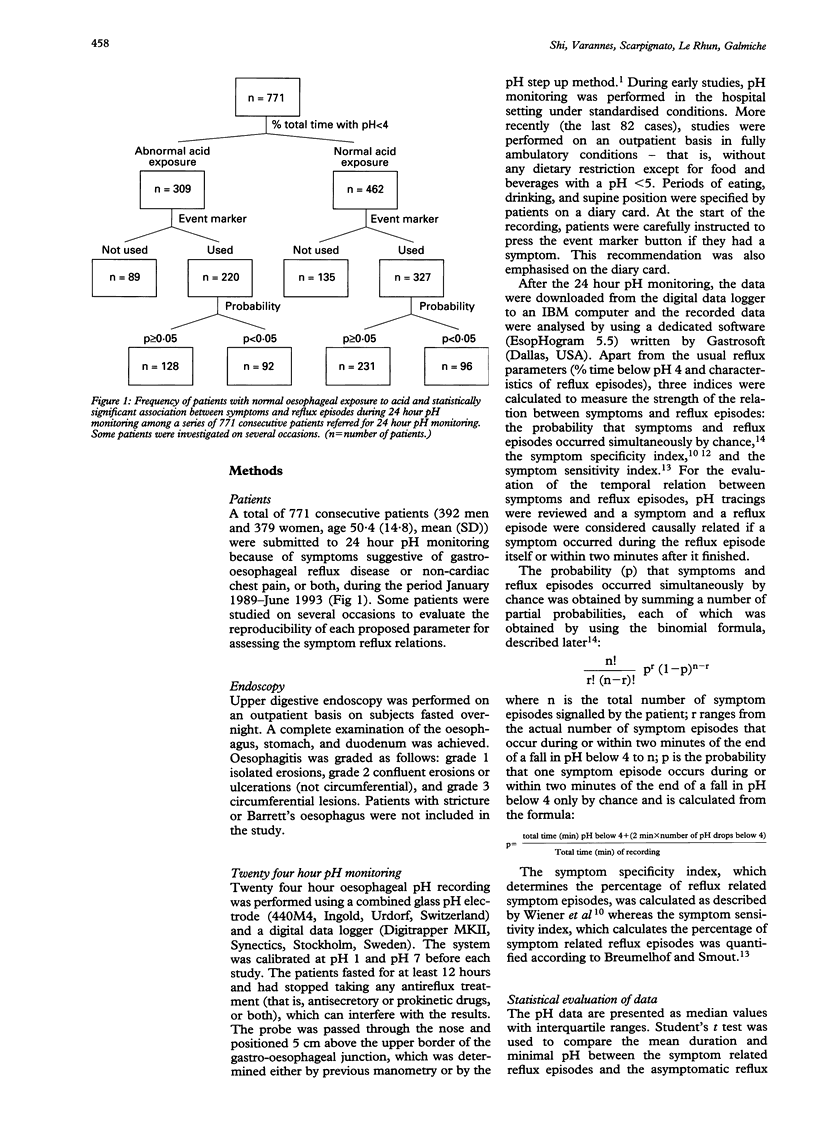
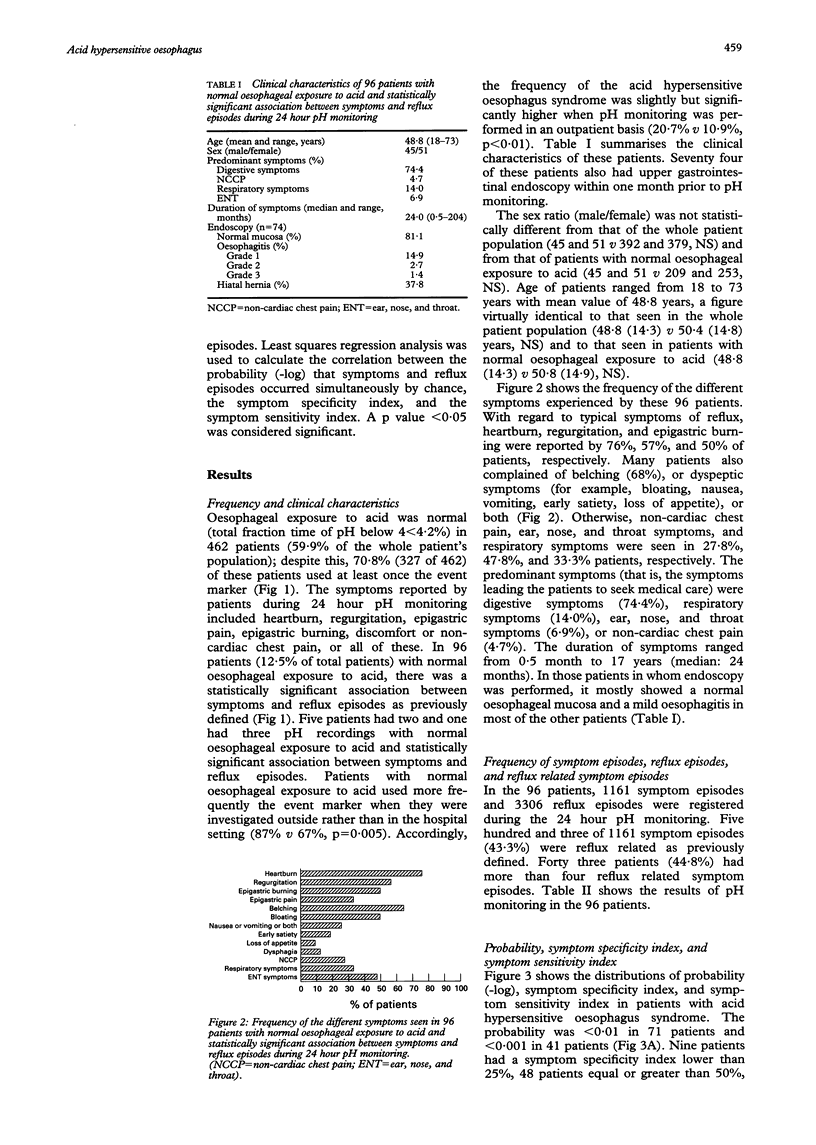
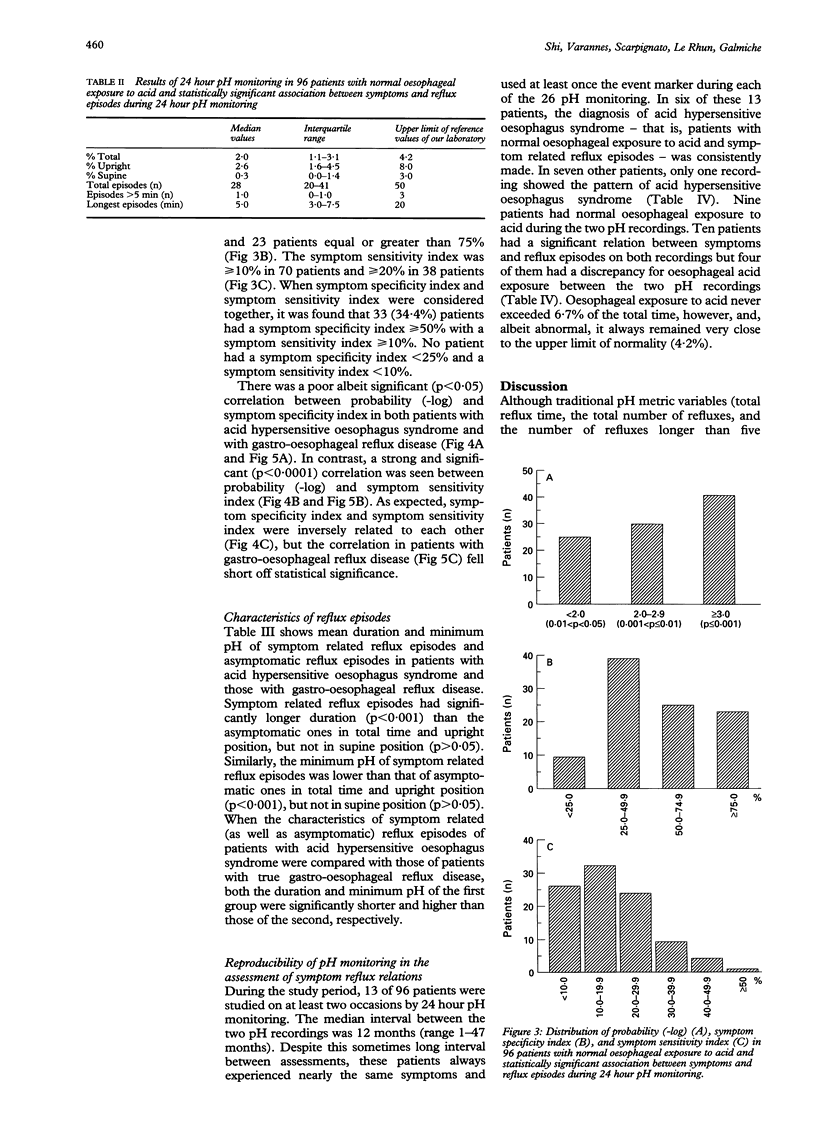

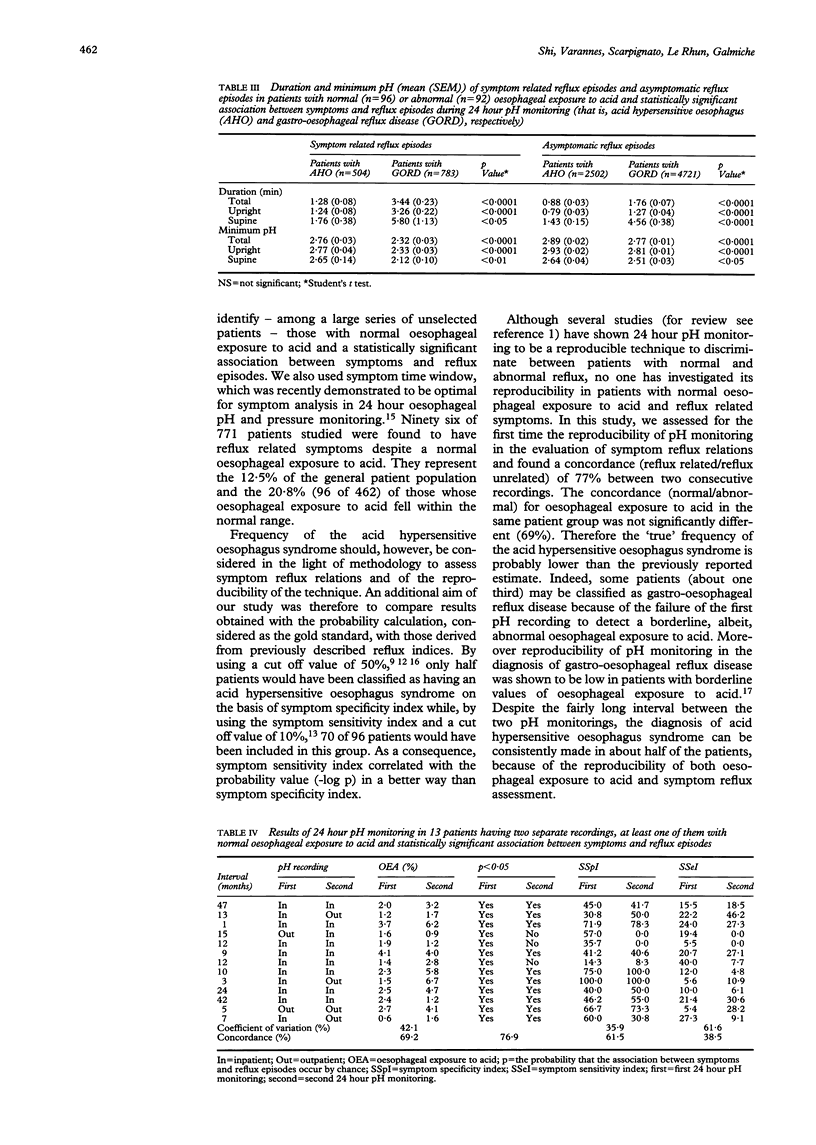


Selected References
These references are in PubMed. This may not be the complete list of references from this article.
- Baldi F., Ferrarini F., Longanesi A., Ragazzini M., Barbara L. Acid gastroesophageal reflux and symptom occurrence. Analysis of some factors influencing their association. Dig Dis Sci. 1989 Dec;34(12):1890–1893. doi: 10.1007/BF01536707. [DOI] [PubMed] [Google Scholar]
- Barré P., Bruley des Varannes S., Masliah C., Cloarec D., Le Bodic L., Galmiche J. P. Le marqueur d'événements: un progrès dans l'interprétation de la pH-métrie oesophagienne. Gastroenterol Clin Biol. 1989 Jan;13(1):32–37. [PubMed] [Google Scholar]
- Breumelhof R., Smout A. J. The symptom sensitivity index: a valuable additional parameter in 24-hour esophageal pH recording. Am J Gastroenterol. 1991 Feb;86(2):160–164. [PubMed] [Google Scholar]
- Eriksen C. A., Cullen P. T., Sutton D., Kennedy N., Cuschieri A. Abnormal esophageal transit in patients with typical reflux symptoms but normal endoscopic and pH profiles. Am J Surg. 1991 Jun;161(6):657–661. doi: 10.1016/0002-9610(91)91250-m. [DOI] [PubMed] [Google Scholar]
- Ghillebert G., Janssens J., Vantrappen G., Nevens F., Piessens J. Ambulatory 24 hour intraoesophageal pH and pressure recordings v provocation tests in the diagnosis of chest pain of oesophageal origin. Gut. 1990 Jul;31(7):738–744. doi: 10.1136/gut.31.7.738. [DOI] [PMC free article] [PubMed] [Google Scholar]
- Hewson E. G., Dalton C. B., Richter J. E. Comparison of esophageal manometry, provocative testing, and ambulatory monitoring in patients with unexplained chest pain. Dig Dis Sci. 1990 Mar;35(3):302–309. doi: 10.1007/BF01537406. [DOI] [PubMed] [Google Scholar]
- Hewson E. G., Sinclair J. W., Dalton C. B., Wu W. C., Castell D. O., Richter J. E. Acid perfusion test: does it have a role in the assessment of non cardiac chest pain? Gut. 1989 Mar;30(3):305–310. doi: 10.1136/gut.30.3.305. [DOI] [PMC free article] [PubMed] [Google Scholar]
- Howard P. J., Maher L., Pryde A., Heading R. C. Symptomatic gastro-oesophageal reflux, abnormal oesophageal acid exposure, and mucosal acid sensitivity are three separate, though related, aspects of gastro-oesophageal reflux disease. Gut. 1991 Feb;32(2):128–132. doi: 10.1136/gut.32.2.128. [DOI] [PMC free article] [PubMed] [Google Scholar]
- Janssens J. P., Vantrappen G. Irritable esophagus. Am J Med. 1992 May 27;92(5A):27S–32S. doi: 10.1016/0002-9343(92)80053-3. [DOI] [PubMed] [Google Scholar]
- Johnston B. T., McFarland R. J., Collins J. S., Love A. H. Symptom index as a marker of gastro-oesophageal reflux disease. Br J Surg. 1992 Oct;79(10):1054–1055. doi: 10.1002/bjs.1800791022. [DOI] [PubMed] [Google Scholar]
- Lam H. G., Breumelhof R., Roelofs J. M., Van Berge Henegouwen G. P., Smout A. J. What is the optimal time window in symptom analysis of 24-hour esophageal pressure and pH data? Dig Dis Sci. 1994 Feb;39(2):402–409. doi: 10.1007/BF02090215. [DOI] [PubMed] [Google Scholar]
- Management of dyspepsia: report of a working party. Lancet. 1988 Mar 12;1(8585):576–579. [PubMed] [Google Scholar]
- Marrero J. M., de Caestecker J. S., Maxwell J. D. Effect of famotidine on oesophageal sensitivity in gastro-oesophageal reflux disease. Gut. 1994 Apr;35(4):447–450. doi: 10.1136/gut.35.4.447. [DOI] [PMC free article] [PubMed] [Google Scholar]
- Richter J. E., Hewson E. G., Sinclair J. W., Dalton C. B. Acid perfusion test and 24-hour esophageal pH monitoring with symptom index. Comparison of tests for esophageal acid sensitivity. Dig Dis Sci. 1991 May;36(5):565–571. doi: 10.1007/BF01297020. [DOI] [PubMed] [Google Scholar]
- Singh S., Richter J. E., Bradley L. A., Haile J. M. The symptom index. Differential usefulness in suspected acid-related complaints of heartburn and chest pain. Dig Dis Sci. 1993 Aug;38(8):1402–1408. doi: 10.1007/BF01308595. [DOI] [PubMed] [Google Scholar]
- Smith J. L., Opekun A. R., Larkai E., Graham D. Y. Sensitivity of the esophageal mucosa to pH in gastroesophageal reflux disease. Gastroenterology. 1989 Mar;96(3):683–689. [PubMed] [Google Scholar]
- Ward B. W., Wu W. C., Richter J. E., Lui K. W., Castell D. O. Ambulatory 24-hour esophageal pH monitoring. Technology searching for a clinical application. J Clin Gastroenterol. 1986;8 (Suppl 1):59–67. doi: 10.1097/00004836-198606001-00009. [DOI] [PubMed] [Google Scholar]
- Wiener G. J., Morgan T. M., Copper J. B., Wu W. C., Castell D. O., Sinclair J. W., Richter J. E. Ambulatory 24-hour esophageal pH monitoring. Reproducibility and variability of pH parameters. Dig Dis Sci. 1988 Sep;33(9):1127–1133. doi: 10.1007/BF01535789. [DOI] [PubMed] [Google Scholar]
- Wiener G. J., Richter J. E., Copper J. B., Wu W. C., Castell D. O. The symptom index: a clinically important parameter of ambulatory 24-hour esophageal pH monitoring. Am J Gastroenterol. 1988 Apr;83(4):358–361. [PubMed] [Google Scholar]
- Zerbib F., Bruley des Varannes S., Oriola R. C., McDonald J., Isal J. P., Galmiche J. P. Alosetron does not affect the visceral perception of gastric distension in healthy subjects. Aliment Pharmacol Ther. 1994 Aug;8(4):403–407. doi: 10.1111/j.1365-2036.1994.tb00307.x. [DOI] [PubMed] [Google Scholar]


